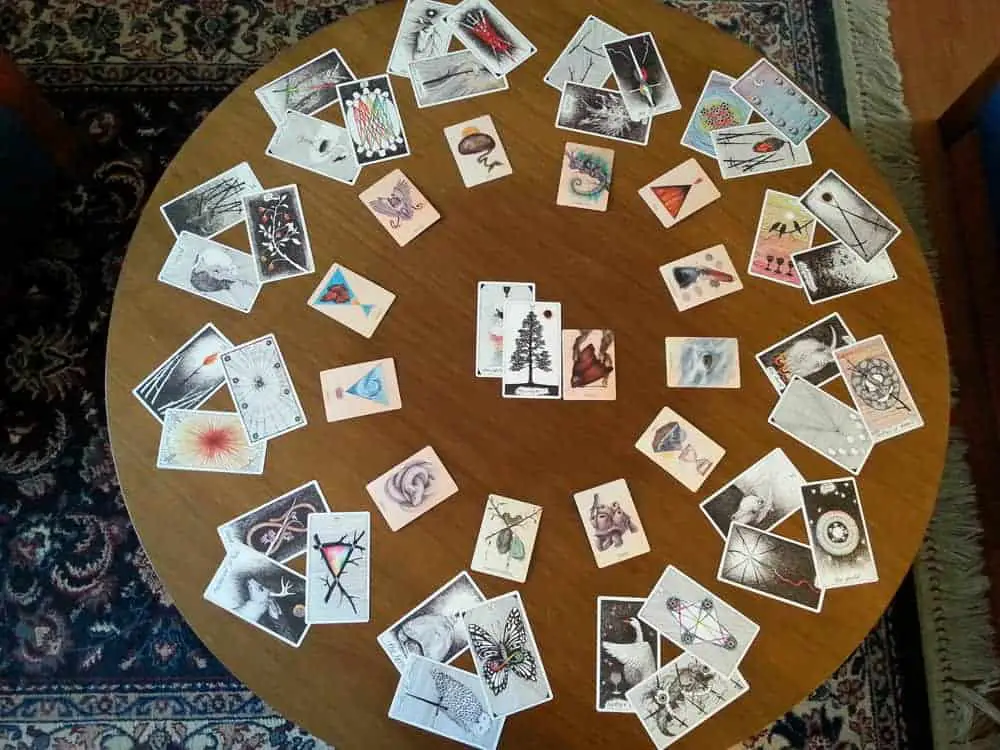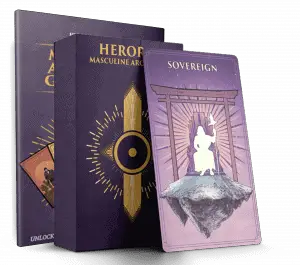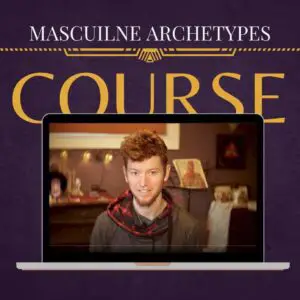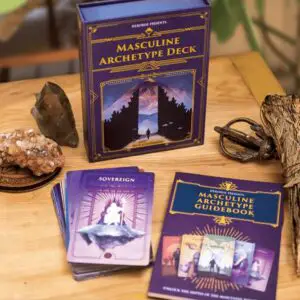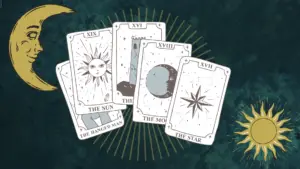Many people are curious about the correct number of cards to pull in a tarot reading. There is no “right” answer, but considerations can help you make an educated decision.
This article will give you an understanding of which number is best for your needs so that you can make an educated decision on how many cards to pull during your next reading.
How many cards do you pull for a tarot reading?
Typically a reading consists of 1-12 cards. Most beginners start with 1-3 cards. The more cards, the more nuanced your reading will become, and the more skill needed.
The number of cards drawn for a tarot reading can vary depending on your experience and your reading goal.
Three things can help you determine the number of cards to pull
1. Your current skill level
I did a poll at herorise.us Instagram about the recommended number of cards based on people’s skill level. I cross-referenced with other readings and community discussions to find a range based on someone’s skill level.
Suggested number of cards based on skill level
| Beginner | Intermediate | Advanced |
| 1-3 | 3-12 | 6-12+ |
If you are brand new to reading tarot and oracle cards, a smaller number of cards can help you focus on the question at hand. If you are more developed as a reader, adding more cards to your reading can help you explore the subtle nuances and patterns surrounding the pondering question.
2. How complex is the question you are asking?
Most tarot and oracle readings are based on asking the cards a question and pulling cards to find guidance.
If you have a broad and straightforward question, then picking one to 3 cards can be enough.
Example; What energy should I look towards today? Should I go out on a date tonight?
If you want more specifics in an issue, five or more cards can help you discover more complex patterns. If you are looking at specific timeframes such as month-by-month timelines, a year in review, or you want to understand the perspective of multiple people in your reading, you might want to pick 12+ cards.
Rough guideline of the number of cards based on complexity:
- Simple question = 1-3 cards
- Specific question = 3-5+ cards
- Complex and layered question = 8-12+
3. Your available time for a reading
When you are doing a tarot or oracle reading, it is best to set aside as much time as the session needs. But… we live in the real world and don’t always have a lot of time.
If you are looking for quick guidance, you might want to pull 1-3 cards. You will want more time to meditate and sit with the cards if you are reading beyond three cards.
Note: the more time you set aside for interpreting the cards, the deeper your reading will become. Try not to get in the habit of always doing a tarot reading while you are on the run. The more time you give, the deeper the information. That goes for any number of cards you pull. Some of my most profound readings have been one card, but I sat with it for a long time.
Using Spreads for your Tarot / Oracle Reading
Most readers use what’s called a Spread. A Spread is a layout of a certain number of cards that are laid out in a pattern. These are commonly used in Tarot and Oracle Readings. You don’t have to use a spread, but it is a great way to explore the cards. It can also help you decide what number of cards you would like to use in your reading.
There are many different types of spreads. They can vary in size and complexity, but the most common ones used by tarot readers or card-readers include:
One Card Spreads: This is a single card chosen to answer a question about your life with little information given at first glance. This type of reading is often done to introduce how one would use cards for divination purposes.
Three Card Spreads: This spread is often used to get a snapshot of the situation. It can help determine which cards are essential or not and how much you should focus on one card over another.
Four card Spreads: This type of reading gets more into detail than other types, but it doesn’t have as much information as an Eight, Ten, Twelve, or Thirteen card spreads might provide; however, it does offer insight that may help make decisions for those looking for clarity.
Eight Cards: The eight-card spread most commonly includes four horizontal rows of two cards each and is typically used by readers to get a more detailed snapshot of the situation.
Ten Card Spread (or Celtic Cross): The ten-card Celtic Cross has become the most popular spread among Tarot card readers. It makes a cross with three cards going down and three cards going across. Then on the side, there are four more cards laid out. This type of reading leads to a thorough exploration of the question asked.
What is the most popular number of cards to pull?
I asked over 100 people (from beginners to professional card readers) their favorite number of cards in a reading, and the most popular answer was three cards.
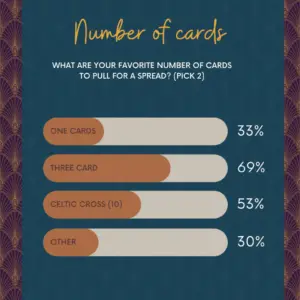
Three cards seem to be just enough cards to help explore the question at hand. It’s easy and fast reading. That doesn’t mean people are only doing a three-card pull; it’s just one that most people recommend and use often.
Is there a limit to how many cards you can pull for a tarot reading?
There is no limit to the number of cards you can pull for a Tarot/oracle reading. You can draw one card to laying out every card in the deck. However, it’s essential to keep in mind the more cards you pull, the more time, skill, and concentration you will need to read the cards.
The most extensive tarot spread I have done is the Year Ahead Spread that I learned from Emily Clare that used 50 cards.
That reading took me a whole evening, but I found it informative. This is not something I would suggest for a beginner, but I share it as an example of how varied a reading can be depending on your desired reading.
In Conclusion
In conclusion, tarot and oracle cards are powerful tools that can be used to delve into the unknown. The number of cards pulled for a reading will depend on three things:
- How skilled/comfortable are you with your deck?
- How much time do you have available?
- And what is the complexity of your question at hand?
Knowing these three factors before pulling any card will help guide your decision about which type of spread best suits your query. There is no one-size-fits-all approach when it comes down to it when picking a reading method – each person has their signature style after all.
Learn more about Tarot and Oracle Cards with these articles:
